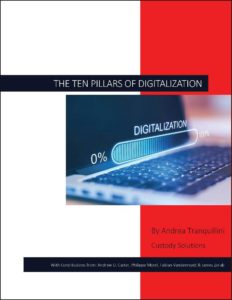The T+1 debate at SIBOS in Toronto this year will examine the challenges of shortening the settlement cycle and gage preparedness of the global Capital Markets and Investors for the North American move to T+1 in May 2024. One of the key benefits of T+1, will be to compel players in the market, to introduce new technologies and innovate solutions towards T+0. Possibly in the not-too-distant future! Today, DLT (Distributed Ledger Technology) and the interoperability of Blockchains, holds most hope for the development of new international Capital Market structures. For many in the industry it’s not what, but how, which is the most difficult question to answer. Shortening the international settlement cycle to T+1 then T+0 appears to offer a compelling driver.
This short paper “The ten pillars of digitalization” written by Andrea Tranquillini, member of the ISITC Europe Advisory Board (with contributions from other leading experts in Custody and the Capital Markets) utilizes his extensive knowledge and experience in building innovation within legacy markets, in particular in applying new technologies to financial market infrastructures. It highlights the lesson learnt in shaping, building and running the only DLT based FMI that the capital market has seen to date, coming to life. The paper then provides a list of the pre-conditions to operate a commercially viable DLT/Blockchain interoperable solution, and consequently should be addressed BEFORE taking the decision of investment.
In particular
- building a new eco system where a language (cryptography) is common to both financial instruments and the infrastructure will not only take time but will requires firm commitment both on funding and feeding (with transactions) amongst the widest possible numbers of market players domestically or internationally.
- Also, more than considering the migration of flows from an efficient “traditional” environment to a “digital” one, the paper stresses the need to look at areas where centralization and harmonization are not advanced, and where greater efficiencies can be introduced into settlement and asset servicing reducing the overall costs of implementation creating increased access, safety and transparency.
Whilst this paper does not provide all the answers to the questions raised by the wide community of the fintech mavericks, it represents a very good starting point for business people and technologists to come together with innovative ideas for the market, but that have to deal with its complex dynamics.
“The ten pillars of digitalization” is small, but useful reading that may lead innovation to success. For the sake not only of digital transformation, but most importantly for the evolution of today’s capital markets into something new and better.
Posted on



Leave a Reply
You must be logged in to post a comment.